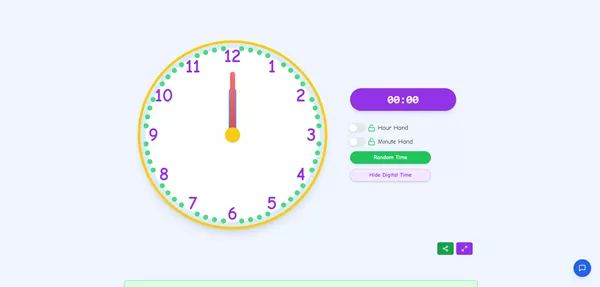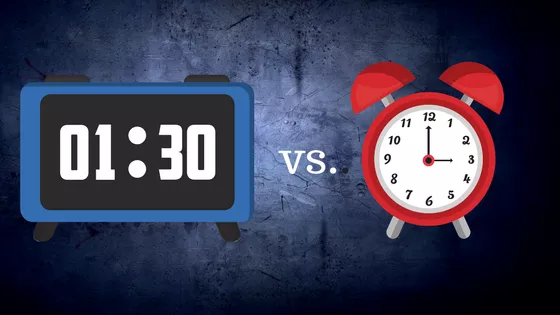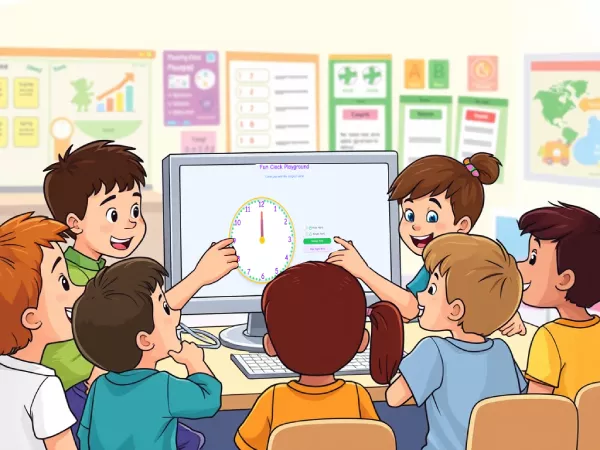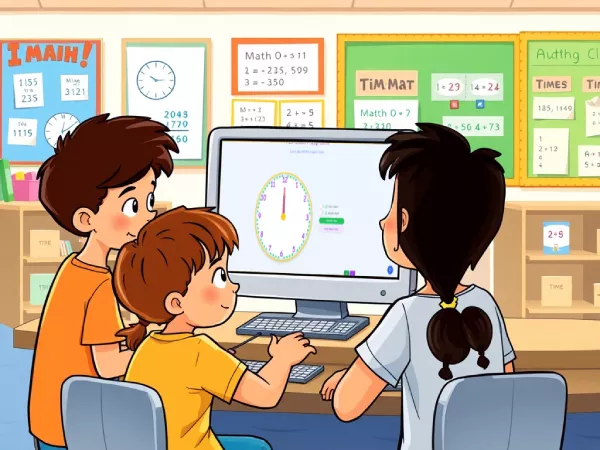Unlock Time-Telling Fun: The Power of Simulation Analog Clocks
Is your child confused by clocks? See how simulation clocks make learning easy! In today's digital age, many children struggle to read traditional analog clocks. This can impact their understanding of time, math skills, and even their daily routines. But what if there was a fun, interactive way to bridge this gap? Enter the simulation analog clock – a powerful tool to help children master time-telling skills while having fun.

The Enduring Value of Analog Clocks
Despite the prevalence of digital displays, analog clocks remain essential for a well-rounded education.

Why Analog Still Matters
Analog clocks offer a visual representation of time that digital clocks simply can't match. Understanding how an analog clock works is fundamental to grasping concepts like fractions, spatial reasoning, and the cyclical nature of time. Even with technological advancements, analog clocks continue to provide value through visual representation. The ability to see time elapse in a circular format offers a cognitive advantage.
The Analog Advantage: More Than Just Numbers
Learning to read an analog clock isn't just about telling time; it's about developing critical thinking skills. Children learn to associate the position of the hands with specific times and to understand the relationship between hours and minutes. This process enhances their ability to visualize and interpret information.
Addressing the Time-Telling Gap
Many educators have noticed a decline in analog time-telling skills among students. This can lead to difficulties in various academic areas and real-life situations. Simulation analog clocks provide a solution by offering a hands-on, engaging way to learn these essential skills.
Simulation Analog Clocks: Making Learning Fun
Simulation analog clocks offer a dynamic approach to learning that captivates children's attention.
Interactive and Engaging Education
Unlike static textbooks or worksheets, simulation analog clocks allow children to actively participate in the learning process. By physically moving the hands of the clock, they develop a tactile understanding of how time works.
Visual Learning: A Hands-On Approach
Our simulation clock provides a visual, hands-on learning experience. Children can manipulate the clock hands, see the correlation between the hands' positions and the time displayed, and thus learn to associate visual cues with time values. This type of interactive learning is more effective than passive memorization.
Transforming Time into a Game
Learning doesn't have to be a chore. Simulation analog clocks can be incorporated into games and activities that make time-telling fun and engaging. This helps children stay motivated and retain information more effectively.

Interactive Features for Effective Learning
Our simulation clock boasts a range of features designed to enhance the learning experience.
Customizable Clock Faces
Tailor the clock to suit your child's learning needs. Adjust the clock face to include or exclude numerals, change the colors, and modify the appearance to create a visually appealing and personalized learning tool.
Random Time Challenges
Put your child's skills to the test with random time challenges. The simulation clock can generate random times, prompting your child to set the clock hands accordingly. This is a great way to reinforce their understanding and build confidence.
Hiding Digital Displays: A Focus on Analog
Encourage independent thinking by hiding the digital time display. This forces children to rely on their understanding of the analog clock, rather than simply reading the numbers. This feature promotes deeper learning and critical thinking.

How Our Analog Clock Builds Time-Reading Skills
Our analog clock is designed to guide children through the process of learning to tell time step by step.
Locking Hands for Focused Learning
Focus on one skill at a time by locking either the hour or minute hand. This allows children to master each concept individually before combining them. This targeted approach prevents overwhelm and promotes a sense of accomplishment.
Step-by-Step Time Mastery
Start with the basics, such as identifying the hour hand and understanding its movement. Then, progress to the minute hand and its relationship to the hour hand. Finally, combine both skills to tell time accurately.
Connecting Clock Time to Real Life
Make learning relevant by connecting clock time to real-life events. Ask your child to set the clock to the time they eat breakfast, go to school, or play their favorite game. This helps them understand the practical application of time-telling skills.
Beyond Time-Telling: Enhanced Skill Development
The benefits of learning to read an analog clock extend far beyond just telling time.

Boosting Math and Fraction Skills
Understanding an analog clock requires a grasp of fractions, such as halves, quarters, and thirds. As children learn to read the clock, they also reinforce their understanding of these fundamental math concepts. You can find more resources on math skills assessment to further support your child's learning journey.
Developing Cognitive Abilities
Learning to tell time on an analog clock stimulates cognitive development by enhancing spatial reasoning, problem-solving skills, and the ability to visualize abstract concepts. These skills are valuable in various academic and real-life situations.
Improving Time Management Skills
By understanding how time works, children can develop better time management skills. They can learn to plan their activities, set priorities, and stay organized. These skills are essential for success in school and beyond.
Engaging Activities with Our Analog Clock
Make learning fun with these interactive activities using our simulation clock.
Time-Based Scavenger Hunts
Create a scavenger hunt where clues are based on specific times. For example, "Find the next clue when the clock shows 3:30." This combines learning with adventure and excitement.
Fun Time-Telling Games
Play games like "What Time Is It, Mr. Wolf?" or create your own time-telling games. These games make learning interactive and enjoyable, helping children stay engaged and motivated.
Creating Interactive Daily Schedules
Involve your child in creating their daily schedule using the analog clock. This helps them visualize their day, understand the duration of activities, and develop a sense of responsibility for their time.
Tips for Parents and Teachers
Here are some helpful tips for parents and teachers to maximize the benefits of our analog clock.
Relating Time to Everyday Life
Connect time-telling to everyday events and activities. Ask your child to estimate how long it takes to complete tasks, such as brushing their teeth or getting dressed. This helps them develop a practical understanding of time.
The Importance of Patience
Learning to tell time can take time and patience. Encourage your child to keep practicing and celebrate their progress along the way.
Celebrating Every Success
Acknowledge and celebrate every milestone, no matter how small. This boosts your child's confidence and motivates them to continue learning.
Give the Gift of Time: Why Analog Clocks Matter
In conclusion, our simulation analog clock offers a valuable tool for children to learn time-telling skills in a fun and engaging way. By providing interactive features, customizable options, and a step-by-step learning approach, our simulation clock empowers children to master time while developing essential cognitive and math skills. Give your child the gift of time and watch them thrive.
FAQ: Your Questions About Analog Clocks Answered
Why are analog clocks still important?
Analog clocks provide a visual representation of time that digital clocks lack. Learning to read an analog clock enhances spatial reasoning, fraction skills, and overall cognitive development. They also offer a unique connection to the history and tradition of timekeeping.
When should kids learn analog time?
Most children are ready to start learning analog time around the age of six or seven. This is when they typically begin to understand basic math concepts like numbers and counting. Introducing the simulation clock at this stage can make the learning process more engaging and effective.
How to make learning time enjoyable?
Make learning time fun by incorporating games, activities, and real-life examples. Use our analog clock to create interactive challenges, scavenger hunts, and daily schedules. Reward progress and celebrate successes to keep children motivated.
Analog vs. Digital: Which is better?
Both analog and digital clocks have their advantages. Digital clocks provide precise time readings, while analog clocks offer a visual representation of time that enhances cognitive skills. Ideally, children should learn to read both types of clocks to develop a well-rounded understanding of time.
Best methods to teach analog time.
The best methods for teaching analog time include:
- Start with the basics: Introduce the hour hand first, then the minute hand.
- Use hands-on activities: Our analog clock allows children to manipulate the clock hands and see the correlation between the hands' positions and the time displayed.
- Relate time to real-life events: Connect time-telling to daily activities and routines.
- Be patient and encouraging: Learning to tell time takes time and practice. Celebrate every success and provide positive reinforcement.
For additional support, consider exploring resources related to dyscalculia test to identify and address any underlying math-related learning challenges. Using a free online test can also provide a quick assessment of your child's current skills.